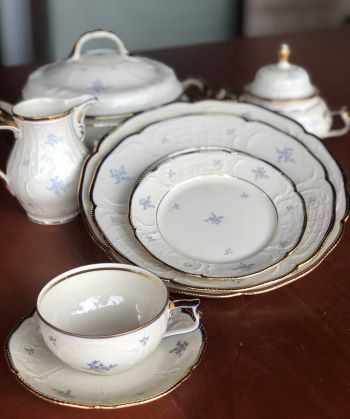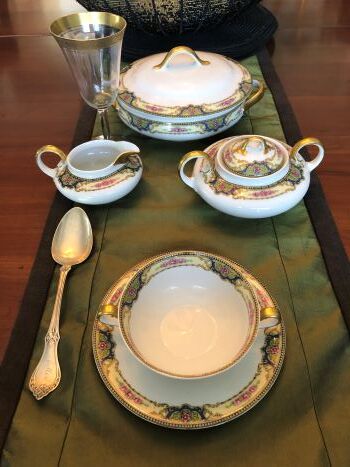 The Rosenthal china with such a long history The Rosenthal china with such a long history My friend Mendel Horowitz, who frequently comments here, has published a lovely piece about dishes that survived the trek from post-war Germany to Philadelphia and will now be used in Jerusalem at Passover this weekend. Mendel is a writer; you may want to read his touching article right now: https://www.jns.org/opinion/our-german-made-passover-seder-plates/ Mendel’s article reinforces connections I recently made between seders and my family’s Easter dinners decades ago – holy days in the early spring, with a touching similarity: the stranger, the visitor, in our midst. I met Mendel through this little therapy website – a rabbi and counselor of men, in Jerusalem, a long way from his childhood home in Queens. He is also a volunteer on emergency calls, never knowing whether the distressed people will be speaking Yiddish/Hebrew/English/Arabic, and it doesn’t matter. Oh, yes, he and his dad, Ahron are Mets fans. Last week I had the honor of “attending” the wedding of Mendel and Michele’s daughter, Leah, on a hilltop in Jerusalem. It was a vibrant, touching ceremony – with young women greeting virtual friends and relatives in distant lands, and the men singing familiar hymns. I was there. This weekend, for the seder, the family will use Rosenthal china that Zaidy Victor and Bubby Bella, Michele’s grandparents, bought and took with them as they escaped with their lives after the war. Last year, Mendel and Leah lugged two knapsacks filled with dishes, bubble-wrapped, on the long flight, just ahead of the pandemic shutdown. (Another stash of dishes is waiting on Long Island for when flying is more feasible.) Sometimes, the dinnerware and familiar furniture are part of the seder. I never attended one as a kid with many Jewish friends in Queens, although I must have gone to half a dozen bar mitzvahs. When I covered religion for the NYT, I was invited to the warm, welcoming Upper West Side apartment of Rabbi Wolfe and Jackie Kelman, our friends and teachers.  An aunt's dinnerware, when the coast is clear An aunt's dinnerware, when the coast is clear The tables radiated with people from all over – a Japanese couple one year, a Caribbean couple one year, lapsed Jews, observant Jews, and Christians like us. One year, as guests were asked to sing, I delightedly recalled a Hebrew hymn I learned in the chorus at Jamaica High School; the next year I sang a bit of “Amazing Grace.” Many of the celebrants stressed the Passover concern for the stranger, the marginal, people who suffer. Only recently have I made the connection with Easter dinners when I was young, when my mother cooked the specialties of England, where she was born – roast beef, Yorkshire pudding, mint sauce. There was one tradition, if you will: at Easter, at Thanksgiving, at Christmas, a family often dropped in for dessert -- a father and his three children. Missing was the wife, my mother’s dear friend at Jamaica High; she had died young, and this good and sad man was raising their children. I don’t recall us ever talking about the absent friend during that visit, but she was there. In every civilization, the stranger is respected. My wife talks glowingly about meals served her in humble homes in India; my sister Janet and I were recently invited to visit (with lavish snacks) our family home in Queens, by the accomplished Muslim family that now lives there. My wife and I are still holed up, waiting for the blessed vaccines to take hold, waiting for “normal times” to return. All three of our children have dinnerware with family histories, and Marianne brings out the Limoges china given us by her Aunt Emma, a sweet old lady who had no children. (Well, except for a dinner on Christmas Eve, years ago, when we entertained Jewish friends who kept Kosher, and Marianne used glass and paper plates. Warm memories.) It makes me happy to think about the Horowitz family celebrating their seder with china that once belonged to their elders – a ritual of continuity, a celebration of survival.
bruce
3/24/2021 11:32:47 am
george,
George
3/25/2021 09:06:00 am
Bruce, thanks for your always interesting comments. My mom was a serious student and went into journalism, had to learn cooking on the fly as her family grew. She was proud of her English heritage -- and invited my first girl friend to a Sunday dinner and cooked her specialty.
bruce
3/25/2021 09:23:57 am
george,
ED MARTIN
3/24/2021 07:44:58 pm
GV, thanks for the lovely tone poem, it is more than prose, it is harmony. Thanks also to Bruce for his in-spirit comment.
George
3/25/2021 09:16:10 am
Ed: thank you for the lovely note....Your friend is from the family that produced the Tilles Center, a few miles from us. Great center for music, etc. Msgr Tom Hartman passed way too young, 69.....he was a landmark, along with Rabbi Gellman...sorry we didn't know each other when you were on Long Island. G&M
Mendel
3/25/2021 04:40:50 am
Thanks for this, George. I have written about Passover more than any other Jewish holiday. The weeks of preparation, links to tradition, and interactive participation are unrivaled on the Jewish calendar. Your aunt's dinnerware looks precious.
George Vecsey
3/25/2021 09:23:00 am
Mendel, thank you for the note. I have had some lovely comments (oin my email) about your essay, the main reason for my followup piece. What a busy few weeks for your family. As for that set we have, my wife informed me it is Limoges....who knew?...the aunt was widowed when I joined the family..she was sweet and generous. I remember loading up our station wagon in Westchester when she was downsizing, and wanted stuff to stay in the family. Not quite the trek your Rosenthal china has made. I am fascinated to read about its origins in Bavaria....and to see its presence on the Web. Amazing they were able to get it to the US after the war...Chag Pesach Shameach. GV
Mendel
3/25/2021 10:28:21 am
After years of mystery, I have recruited a historian to investigate the origins of the dinnerware and the role my father-in-law's father played in the Foehrenwald DP camp. I suspect the Rosenthal china was purchased (bartered?) prior to leaving Germany for Philadelphia.
Randolph
3/26/2021 07:20:55 am
Today’s New York Times has an obituary of Bobby Brown, former New York Yankee.
George
3/26/2021 06:18:03 pm
Randy: Thanks for noticing, My friend Rich Goldstein writes most of the sports obits for the NYT....No royalties for old stories done on company time...I remember the interview, at their home in Fort Worth, after I wrote a column from the NY Giants at Dallas Cowboys that afternoon. I liked Bobby and Sara Brown...best GV
Gene Palumbo
3/27/2021 02:32:39 am
For those of you don't subscribe to the Times, the Bobby Brown obituary will be behind a paywall. I couldn't bear the thought of you missing this:
bruce
3/27/2021 06:00:08 pm
gene, Comments are closed.
|
Categories
All
|









